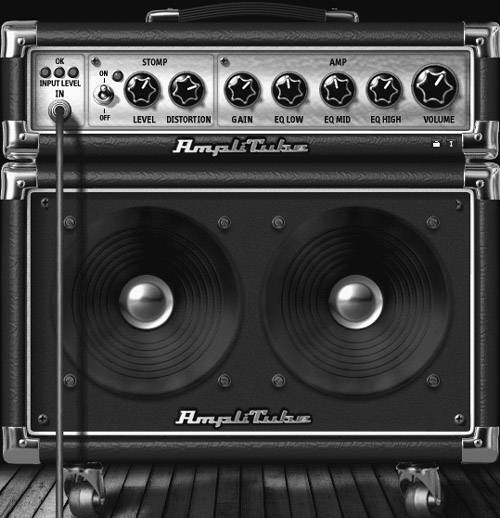Specialized Processors
Distortion
Distortion is one of those things novice recordists are taught to avoid, but as early electric guitarists discovered , it can be as essential an effect as EQ and compression. Electric guitars actually sound thin and weak without some distortion. One reason why players choose particular amps is to add the timbral qualities of gentle (or not-so-gentle) analog tube distortion. Without it, the sound of the instrument is actually quite dull. You can also use distortion to process anything from vocals to keyboards to drum loops , sparingly or in massive quantities .
| | What distortion does: Produces "bad" sounds that sound "good," either the warm, fuzzy crunch of analog distortion or the glitchy, hard-edged destruction of digital distortion How to use it: Turn up the effect a little for a subtle effect or a lot for sonic mayhem When to use it: Essential for producing the customary sounds of guitars and vintage keyboards, but can also be added anywhere some crunch is desired to create a slightly dirtier sound or for more irreverent special effects |
There are many flavors of distortion, but a typical distortion effect uses an amplifier to increase the volume of the input sound, bringing it up to or beyond the headroom available either in the actual circuitry or in a software reproduction thereof. Distortion is an amplitude-dependent effect, which means that changing the input amplitude alters the harmonic character of the output. Typically, distortion alters the loudest peaks of the waveform and in the process adds harmonic content to the sound. The most common parameters are:
-
Level: Alternatively referred to as amount, drive, crunch, fuzz, dirtiness, ugliness, or various expletives depending on the creativity of the effect's designer, all of these parameters control one factor: the level of the amplifier and thus the amount of the distortion effect.
-
Tone: Because distortion adds harmonic content, a simple filter is often added to the output to control the timbre of the effect. Generally , a filtered sound will be warmer and less edgy, whereas an unfiltered sound will be harsher or "dirtier." A few distortion effects also have a filter on the input, allowing you to boost certain overtones and thereby change the character of the distortion.
Analog devices naturally tend to add warm distortion because of the physical properties of analog circuitry and tubes. But in the absence of these properties in the digital domain, digital effects must simulate analog distortion by emulating their effect on the sound. There's a variety of breeds of distortion, each of which is specific to the way certain circuitry or algorithms respond timbrally.
General distortion effects
Various analog-style distortions can be accomplished, either with actual analog circuitry or software emulation. (See three examples in Figure 7.34 .) All are capable of producing warm, pleasant distortion or more grating distortion that is nonetheless organic in character:
| | The terms fuzz, overdrive , and distortion are often used interchangeably to describe the distortion effects found on guitar distortion pedals and overdriven analog equipment. Fuzz and overdrive usually refer to transistorized distortion, which produces a harsher sound. |
-
Overdrive: If it lacks a more specific label, an overdrive or simply a distortion effect often emulates the distortion generated by transistor circuits. These are the most common distortion effects, and they can sound pretty raunchy.
-
Tube distortion: Tubes distort in a gentler, warmer fashion than transistors , an effect that software can emulate through a variety of means. Some new hardware even resorts to using actual tubes to get the effect right.
-
Exciters: Exciters and enhancers are subtle distortion effects that produce artificial harmonics in a high-pitched range, where they add sparkle to dull recordings.

Fuzzy wah: Combine fuzz distortion with a wah filter (see p. 253) for a distinctive dirty, modulated sound that's popular on keyboards, organs, and guitars. (See Figure 7.34 for an example.)
Figure 7.34. Three typical examples of software distortion: from left to right, DaTube is a tube distortion emulator from Cubase SX; the aptly named Grungelizer, also from Cubase SX, simulates vinyl equipment and low-fi analog gear; and the Fuzz-Wah effect from Logic Pro combines a fuzz distortion effect with a wah modulator .

-
Guitar amps: Guitar amp simulators combine tube or other distortion effects with some means of modeling the effect of the physical amp cabinet on the sound. Some even emulate specific amp-miking setups. Amplitube Uno, for example, included on the DVD, is a simple amp simulator with guitar effects.
-
Turntable (vinyl) distortion: Turntable distortion involves two elements, harmonic distortion and added noise. Even- and odd-harmonic distortion occurs naturally because of the geometric relationship of needle to groove when the tone arm of a record is set incorrectly. Random noise or "crackle" occurs when the needle runs across dirt and scratches on the record. Software is capable of digitally reproducing both, although many musicians prefer to simply record the latter effect using an actual record, by sampling part of the record that's otherwise silent and mixing it in with digital recordings.
Digital distortion
Digital distortion can be generated by amplifying a signal past the available capacity of the circuit or software (overdrive), or by forcibly truncating the sound to a lower bit rate and/or sampling resolution. Both methods create garish electronic sounds:
-
Overdrive: As opposed to the fuzzy, rough-edged distortion generated by analog circuitry, overdriving digital circuitry or software chops off the tops of waveforms, creating a flat-topped wave shape that sounds similar to a square wave. The sound is intense , and unlike the product of analog distortion, is often radically unlike the original source. Use this technique with caution: the result is painful and sometimes dangerous to your equipment and hearing, so turn down your monitoring level.
-
Downsampling/bit rate reduction: Like digital overdrive, bit rate and downsampling effectsoften called bitcrushers ( Figure 7.35 )take advantage of an aspect of digital recording you normally try to avoid. By aggressively reducing either the number of bits used to encode the audio or the sampling frequency (or both), data loss and aliasing introduce pitched artifacts and noise. With a modest reduction, your tracks can sound as though they're being played by a used Nintendo game system or early '80s computer. With additional reduction ( decreasing the available bandwidth by an exponential factor), you'll hear harsh , "screaming" digital effects.
Figure 7.35. Looking for a way to make your $6,000 digital setup sound like a $20 purchase from eBay? Ableton Live's Redux could be your solution.

-
Distortion without overdrive: Waveshaper distortion is a digital distortion process that doesn't overdrive the signal or introduce clipping. Instead, it reshapes incoming signals, remapping each sample word of the input to a new output sample at the waveform level, adding the harmonic tones that make distortion desirable. Waveshapers typically provide controls over input scaling (the degree to which the effect is added), and tonal controls for different effects like imitating tube distortion.
Modulation
When you take a sound source and transform it in a rhythmic, repetitive way over time, whether by moving a knob or speaker back and forth or even by cupping your hand over your ear, you're modulating the source.
| | An oscillator is any signal source with a continually changing value, whether it's a simple sine wave, repeating on/off switch (square wave), or even an audio sample. |
The simplest modulation effects apply a regular, repeating transformation, such as you'll hear coming from the Leslie rotary -cabinet speaker often used with Hammond organs: a motor in the cabinet physically rotates the speaker in a circle, which causes the sound to bounce off of nearby walls to create an effect that is at once spatial, spectral (because of phase cancellation between certain overtones when they bounce off of different walls), and pitch-based (because the Doppler effect is introduced by the speaker's motion). Once the rotation speed is fast enough, instead of hearing discrete sweeps , you'll hear a beating or tremolo effect.
Modulation effects work on the same principle. Instead of using mechanical modulation, as in a rotating speaker, they apply a regular change to a specific parameter of the effect, such as a filter cutoff frequency. The most common modulation source is a simple low-frequency oscillator (LFO). Quite often the LFO is used to produce a sine wave, which since it represents the shape of a continuous circular motion is perfect for creating sounds like the rotating Leslie. (In fact, you could rightfully consider the motor of the Leslie a mechanical sine-wave oscillator!) Other modulation effects can be achieved with other waveforms or signal sources. A triangle wave, for instance, is commonly used to achieve effects like panning modulation, because it moves evenly between two values. (For more information on different waveshapes and their use in both synthesis and modulation, see Chapter 9.) Using an oscillator to move a setting up and down is basically the same as taking a knob and repeatedly turning it up and down, but with automation.
LFO
Because an LFO (low-frequency oscillator) cycles more slowly than an oscillator intended to directly produce sound, it can be used as a modulation source to produce sweeps whose individual ups and downs are audible. For example, if a sine wave LFO is set to 1 Hz and the sine wave is used to modulate the cutoff frequency of a filter, the cutoff will sweep through its range once every second, producing a 60 bpm wah-wah-wah effect. Using a 1 Hz LFO is equivalent to physically rotating the knob back and forth once every second.
LFOs are employed in numerous types of modulation effects, from simple tremolo and wah filters to elaborate "auto-filters" that resemble synthesizers more than filters; see Chapter 9 for more information on filtering in a synthesis context.
General modulation applications
You can achieve a number of effects with a simple, regularly repeating LFO, so they're typically built into effects with modulation features, or can be applied to any signal you wish in modular environments like Reason, Reaktor, and Max/MSP. Effects based on this form of modulation are popular in vintage keyboards, guitar effects, and organs. They often create interesting effects when applied to other sources as well. The following settings are the most significant (covered in greater detail in their specific synthesis and instrumental applications in Chapter 9):
-
Waveform: Some LFOs will produce only sine waves, but triangle, square, ramp, and sample-and-hold options are sometimes available. (See the explanation of basic waveform types in Chapter 9.)
-
Rate (speed): The frequency of the LFO, and thus the frequency of the effect. If you're lucky, your effect will offer a sync option that automatically matches the effect rate to the tempo of your music in case you want a beat-locked effect. In this case, you'll likely see a menu of rates that includes real-world note values, such as sixteenth-notes.
-
Depth: Range of modulation that will be generated by the LFO.
-
Phase: Also called stereo width , the phase setting controls the degree to which the modulation wanders between left and right stereo channels. If degrees are used instead of a percentage, choose 180 ° to center the effector 180 ° to shift between channels.
-
Dry/wet: Mix of the effect.
Because some LFO-based effects are similar to one another and all create different variations of a "swirling sound," they're often confused . Some vintage guitar equipment even labels effects incorrectly! Different effects do result in different sounds, however:
-
Tremolo (amplitude): The LFO modulates amplitude , either in mono or separately for left and right channels; typical of vintage guitar amps and many synths ( Figure 7.36 ). If the LFO is inverted in the left or right channel, so that the amplitude of one channel increases while the other is decreasing, the tremolo effect becomes a stereo panner.
Figure 7.36. Regular modulation of amplitude creates tremolo. You can see the regular "swirling" shape of the amplitude here. Logic Pro's Tremolo effect has separate controls for left and right channels so the effect can operate in stereo.

-
Vibrato (frequency): The LFO modulates frequency (pitch). (This terminology will make sense to string players: tremolo is achieved by rapidly repeating a note with the bow, whereas vibrato involves bending the pitch up and down with the finger.) The major characteristic of a Leslie rotary cabinet is vibrato, which is created by the Doppler effect as the speaker twirls.
-
Chorus/ flanger (delay): The LFO modulates the delay time of a short (less than 50 ms or so) delay line. The delayed signal rises and falls in pitch due to the modulation. When the dry signal is combined with the delayed signal, phase cancellation causes the overtones of the sound to beat in a way that sounds rich and pleasing. The shorter the delay time, the higher pitched the phase cancellation will be. Increasing the delay feedback will intensify the effect. Some chorus effects include several independent delay lines, each of which delays the input by a different amount and is modulated by an LFO with a slightly different rate. These multi-voice chorus effects can produce a very rich sound. In flanging, the delay time is typically shorter and more feedback is used.
-
Phaser (filter): Phasers use one or two independent LFOs to create a phased modulation of filters . Shifting nonharmonic notches in the spectrum or comb filtering creates a distinctive sound that has been wildly popular for use with electric pianos since the '70s.
Hands-on: Modulated Filter in Ableton Live
| |
The brilliance of modulated filters is the ability to create changes over time, and if you like, sync them up to tempo so those changes occur in time with your music. We'll use Ableton Live's Auto Filter for some basic, rhythmic sweeping effects.
-
Add the Auto Filter: Find a track with a wide frequency rangedrums are a good choiceand drag the Auto Filter from the Device Browser. You'll see a familiar parametric filter (1), but now you can modulate it over time, with the LFO (2) and time sync options (3).
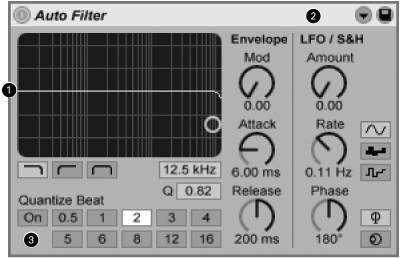
-
Adjust the filter: Let's forget about frequency and Q for a second: drag the round ball on the filter up and to the left until you've made a major impact in sound. Drag it in different patterns, and you'll see why a filter like this is a great candidate for assigning to a MIDI controller. You can choose a peaking or high/low-cut filter; place it where you like and make sure the round ball has a high value vertically (high resonance /Q).
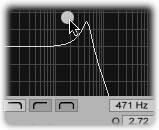
-
Add LFO modulation: Now we'll modulate the effect automatically, putting the "auto" in "auto filter." Increase the Amount knob on the LFO, and you should begin to hear a regular change. (If not, increase the Amount, or try moving the filter around.) Adjust the Rate knob to change how quickly or slowly the LFO sweeps through its changes. Remember, 1 Hz is once per second, so an LFO rate of 10 Hz will create ten sweeps each second.

-
Create different modulation shapes : Ready to spice up your filter effect? By default, the LFO sweeps gradually through settings (1). By switching to one of the stair-stepped "sample & hold" modes (2), you can use abrupt changes instead. By adjusting the phase control (3), you can create an effect that moves in stereo between your left and right speakers. For more stereo action, spin mode (4) creates different LFO rates for your different speakers . You can also shape the effect itself with the envelope controls: start by increasing the Modulation value (5).
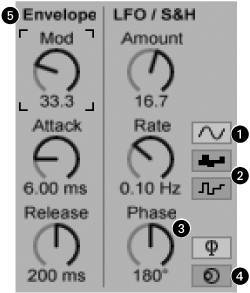
-
Sync the effect to tempo: Any effect that's measured in time, including an LFO, has to be manually adjusted to the tempo so that it lines up with beats in the music. Using a tempo-slaved effect, you can have settings automatically shift in time with your music. Click the sync button, then choose a time interval in sixteenth-notes (so 4 is one beat, 2 is half a beat, 16 is a bar of 4/4 time, etc.). As you adjust the global tempo setting of your software, the effect will respond automatically.

Other software: Look for two key parameters that mean you can have fun with a filter using modulation: "LFO" and "sync." If they're available, try sweeping analog-style shifts or beat-synced rhythmic effects.
Ring modulation
Ring modulation (ring mod for short) is an effect in which an audio source is modulated either by an internal oscillator or by another audio input ( Figure 7.37 ). The ring modulator outputs the sums and differences of all of the frequency components of the two signals. That may sound a bit oblique to read, so your best bet is to try out a ring modulatorthe sound is unmistakable. The sum and difference process creates upward and downward shifting of the frequency spectrum, not simply of the pitch. This has a radical impact on harmonic relationships, so the main appeal of the ring mod is that its output often sounds almost nothing like its input!
Figure 7.37. The Moogerfooger ring modulator lets you modulate an input with an adjustable LFO. Bob Moog didn't invent ring modulation, but he helped popularize it; retro-style ring modulators that sound like his original hardware are available in new hardware form and in software emulation via Bomb Factory for Digidesign Pro Tools.
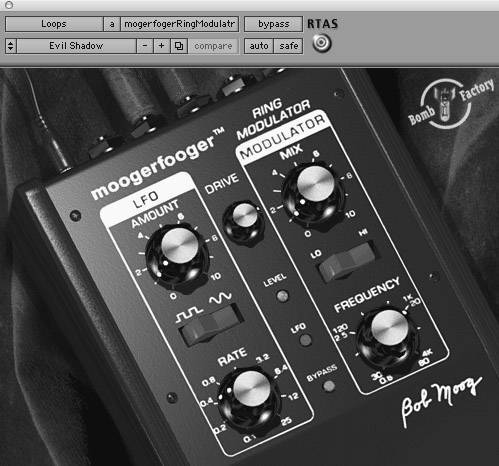
| | What ring modulation is: A means of modulating sound that outputs the sum and difference tones of all of the overtones in two signals How to use it: Feed an audio input and set an amount (using either a second audio signal or an internal oscillator as a modulator) When to use it: Create rich phase effects, metallic sounds, and evil alien voices shouting,"Resistance is useless!" |
In small amounts, ring modulation can create phasing -type effects, whereas greater amounts generate strange metallic, clanging sounds. The alien sounds that result have popularly been used for the robotic sounds of Star Wars characters and are associated with the evil Daleks of British sci-fi TV show Doctor Who . (British electronic music mavens debate exactly how the latter was created, although the process must certainly have been ring modlike in the early days. In fact, engineers on a new BBC show are using new Moog ring mod hardware.)
Vocoder
Short for VOice enCODER, the vocoder was originally developed for low-bandwidth (and, if need be, secret) transmission of voice messages. The "magic" of the vocoder was based on an understanding of how speech works, separating the production of the raw vocal sound (vocal cords) from the message (the words formed by your mouth). You'll find vocoders today as plug-ins, and in some synth and effects hardware, including some popular keyboards like the Korg MicroKorg and Alesis Ion/Micron.
| | What a vocoder is: A means of analyzing and "resynthesizing" audio by combining two signals: the characteristics of one, broken into frequency components and their relative strengths, are applied to another How to use it: Feed two audio inputs to the vocoder: one signal (the carrier) to be heard in processed form, and another signal (the modulator) to provide the harmonic spectrum that will be imposed on the other. Alternatively, with a vocoder that generates a synthesis signal via built-in oscillators , combine the built-in carrier signal with an external modulator. When to use it: To create robotic-sounding vocals, synthesizedsounding timbral effects, and dramatic, far-out filters |
Here's how it works: human speech can be considered to have two main components: the basic sound of your vocal cords (in terms of the vocoder, the carrier), and the modulating effect of your mouth, which produces vowels like "ooh" and "ah." What we hear as speech is a mix of the basic vocal cord sound and the filtering effect of your mouth. The idea behind the vocoder is to break up speech into those two components and then put them back together again, by applying the analyzed qualities of the formants (modulation) to a basic sound (carrier).
To use a vocoder, you'll need two inputs: one will act as the modulator (the equivalent of the formants of your mouth), and one as the carrier (because it will "carry" the qualities of the modulator as the output signal).
-
Modulation audio source (a.k.a. "analysis" signal or "formant" source): The modulator is routed into a bank of bandpass filters, which divide the signal into frequency components. Envelope followers then measure the moment-to-moment amplitude level of each frequency component, providing a group of simultaneous control signals that will be applied to the carrier. (If you're using speech, this is the speech source.)
-
Carrier audio source (a.k.a. "synthesis" source): The carrier is sent through its own set of corresponding bandpass filters. Usually a harmonically rich sound (such as a synthesizer sawtooth wave) is preferred for the carrier. The control signals generated by the modulator's envelope followers are routed to level controls for the outputs of the carrier's bands (sometimes called Voltage-Controlled Amplifiers or VCAs), so that the level of each band in the carrier is controlled by the level of the corresponding band in the modulator.
You don't hear the modulator signal in the final output; instead, you hear the output of the carrier signal after it has been transformed by the modulator signal. (See Figure 7.38 for a diagram of the routing scheme.) Because vocoding requires two audio inputs, you'll need either a vocoder with a built-in synthesis engine (for providing the carrier), or a side-chained second input. (Since some hosts don't provide side-chaining capabilities, this can lead to some awkward work-arounds; you'll need to check the documentation for your host and vocoder.) The advantage of using a synthesizer as the carrier source is you can easily adjust the frequency of the carrier, or, if the synthesis source allows, even "play" the vocoder with a MIDI input. (See Figure 7.39 for an example vocoder from FL Studio.)
Figure 7.38. The basic routing scheme for a vocoder. Two inputs are processed into a single output.

Figure 7.39. A classic vocoder effect, as featured in FL Studio, with controls for the synthesis source (1), bandpass filters (2), envelope follower (3), and mix between the carrier and modulator and dry and wet effect (4).

Each step of the process of the vocoder process provides options for controls; which are adjustable depends on your individual vocoder, but possibilities include:
-
Oscillator: Vocoders with a synthesis section for providing the carrier internally will have controls for generating different kinds of signals. (If you're using an external source, these will be irrelevant, and some vocoders lack internal oscillators.)
-
Filter banks: Various controls for the filter banks let you adjust the timbre of the vocoder's output, by adjusting the filters for the carrier and modulator. You may be able to switch the number of bands. Increasing the number of bands requires more CPU processing, and the pinpoint accuracy provided by a high number of bands can actually make the "speech" effect less intelligible rather than more. (Some vocoders have fixed filter banks and settings.)
-
Envelope: Parameters for the envelope follower let you adjust how the carrier responds to the modulation source.
-
LFO: Some advanced vocoders can even modulate the modulated signal via an LFO or other modulation source, for shifting and sweeping filter effects.
-
Voiced/Unvoiced: Since human speech is a combination of voiced sounds (tonal sounds and vowels) and unvoiced sounds ( noisy sounds, mostly the high-pitched noise found in consonants like "s" and "th"), a vocoder capable of high-quality vocal reproduction will include parameters for triggering different sounds for each in the synthesis engine.
-
Mix Levels: Level settings allow you to add some unprocessed carrier or modulator signal in the output.
For the classic vocoder speech effect, the modulator is a vocal input, but it doesn't have to be. For instance, you could modulate a string patch with drums, or any other combination of inputs. You will need to use inputs that have similar spectral content for the vocoder to be effective, however. Inputs in the same pitch range work best. If you don't hear the effect you want, you may want to try compressing and/or overdriving the dynamics of a carrier signal whose dynamic level changes too drastically.
| | What pitch correction is: An effect that automatically makes pitch changes to incoming audio signal, mapping the intonation of instruments or voices to a scale or mode How to use it: Hook up an audio input, define a scale for tuning (either using a pre-defined scale, like E major, or creating a custom tuning map), and set timing and sensitivity controls When to use it: Fix minor intonation problems with instruments and vocals, map sounds to exotic tunings, or create special effects with extreme settingsjust don't expect any miracles with a horrible singer |
| | Where you've heard vocoders: The robotic, " singing computer" effect of a classic vocoder has been used in songs like Wendy Carlos's "Timesteps" in Stanley Kubrick's film A Clockwork Orange (in which a vocoder sang Beethoven's "Ode to Joy"), by Laurie Anderson ("O Superman!"), Kraftwerk ("We Are the Robots"), Daft Punk, and to more subtle effect with Star Wars' Darth Vader. If you're not a fan of the classic effect, though, vocoders with 16, 20, or more bands and non-vocal use are capable of producing unusual filtering effects that sound nothing like any of these examples. |
Pitch Correction
Using real-time FFTs, pitch correctors like Antares' AutoTune ( Figure 7.40 ) can remap a monophonic (one-voice) audio signal to a scale or mode for fine-tuning a vocalist or for special effects. Pitch correction plug-ins only correct intonation; they can't turn a lousy singer into a good one. They're best at adding minor pitch corrections to a few notes here or there, which can rescue a take that's nearly perfect except for a few small intonation problems. Plug-ins of this type are generally faster and easier to work with than the laborious process of selecting individual notes and manually adjusting the pitch. That's the reason why pitch correction has started to show up even in consumer-level software like Apple's GarageBand (albeit minus a lot of the power and control of a professional tool like AutoTune).
Figure 7.40. Antares'AutoTune (www.antarestech.com) is a ubiquitous plug-in for pitch correction, with many advanced settings for customizing tuning and timing, or, if you prefer, some default automatic settings that work for many music styles.
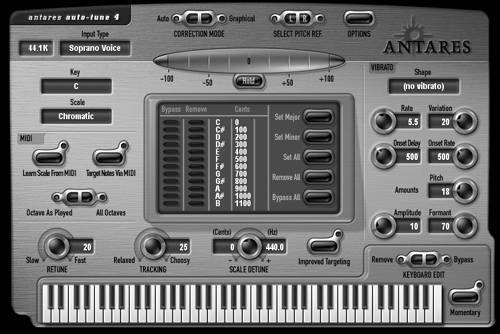
| | Where you haven't heard pitch correction: Contrary to widespread belief, the effect in Cher's "Believe" is not an extreme application of AutoTune: it's a good, old-fashioned vocoder. High responsivity settings in AutoTune will produce a "flipping" sound as pitch translates from one note to another, but not the robotic effect heard in the song. Producer Mark Taylor told Sound on Sound magazine in 1999 that the effect was a DigiTalk vocoder. (http://www.soundonsound.com/sos/feb99/articles/tracks661.htm) |
The more expensive pitch correction plug-ins used by professionals offer all kinds of customization and control, but two basic parameters are the most significant: the tuning table, and the response or timing. The tuning table is the scale or mode to which you wish to tune; it could be C minor, E Phrygian, a drone, an Indian raga, or a custom tuning of your own design, depending on how customizable your pitch correction tool is. The most common application, of course, is simply to choose the key and mode of the song and use pitch correction to automatically correct notes from your singer or instrumentalist to the proper intonation. However, other special effects are possible by " abusing " the settings.
| | Black gold: The technology for AutoTune was originally a seismic data analysis process called auto-correlation, used to locate underground oil. The technology turned out to be gold for Antares Technology's founder, an ex-oilman; many people refer to pitch correction simply as "AutoTune." |
Timing controls determine how quickly the notes will be adjusted to the "correct" pitch. Make the plug-in too responsive by setting the timing too short, and the output sound will "flip" up or down to a note in an artificial way; set timing too long, and you'll be able to hear the pitch corrector changing the pitch. Finding a middle ground is essential to producing natural-sounding results, though again some producers have experimented with intentionally choosing extreme settings for special effects.
Pitch correction has become widespread in commercial studio recordings, which has also made it controversial . It is possible to overuse automatic pitch correction, which has added to complaints about modern pop songs sounding artificial and "over-produced." Great singing often doesn't correspond to the plain- vanilla tuning of a modern piano. Classical singers sometimes make sharped notes slightly higher and flatted notes slightly lower, while rock, jazz, and blues traditions have long involved nuanced bends around pitch. Misused or overused , pitch correction can erase some of the human elements that make vocals enjoyable. It's important to remember that, like all effectsEQ, compression, reverb, and delays includedpitch correction can't make a mediocre singer sound great. (In fact, if you do want to radically change the way a vocal sounds, your best bet is a vocoder.) In smaller doses, though, pitch correction can save recording time and rescue a good but imperfect recording.
| | What noise reduction/restoration is: A specialized plug-in for eliminating unwanted sounds from a recording, particularly broadband noise like tape hiss or air conditioner noise. (Many general-purpose restoration plug-ins combine various functions beyond simple noise reduction.) How to use it: Adjust plug-in settings to strike a balance between removing unwanted noise and maintaining the program material you want heard. With broadband noise reduction, this often involves sampling noise in a spot on the recording where only the noise can be heard. This "noise profile" can then be applied to the rest of the track. When to use it: While restoration tools usually can't rescue recordings that are so far gone that you hear mostly noise, they are useful for fixing more minor problems like removing hiss, ventilation noise, vinyl pops, and related issues |
Noise Reduction/Restoration
There are a variety of solutions to removing unwanted sound from a recording. You can manually edit out pops and clicks with a sample-accurate waveform editing tool, though that process can be time-consuming . You can reduce noise and hiss with filters, but that can remove too much of the sound you want to keep. You can use noise gates to remove broadband noise, but that does nothing for noise that overlaps with your program sound.
General-purpose restoration plug-ins and noise reduction processors are designed to address these problems in real time, via a combination of specialized techniques and some of the previously-mentioned, generic processors, adapted to the purpose. These tools can help with:
-
Broadband noise: Specialized noise reduction tools remove sounds like wind, fluorescent lighting hum, hiss, and other noisy sounds. This includes FFT-based reduction, which attempts to identify noise by its spectral content. Some processors sample noise from a location on the recording that contains only that ambient noise; select a portion of the waveform containing only noise and hit a command like 'sample' or 'learn,' and the noise reduction plug-in will attempt to remove that content from the rest of the file.
-
Clicks, pops, and crackles: Analog pops and crackles created by dusty records or digital clicks and other recording problems are all forms of unwanted transients. They can be removed with specialized real-time digital pop filters. Some are fairly automatic, while others require that you select the region containing the unwanted pops.
-
Hum and rumble: Hum created by sources like power sources and various sources of low-end rumble are frequency-specific problems. As such, they're best solved by a notch filter or narrow parametric filter. You can use an EQ for this purpose, but some specialized restoration tools also incorporate filtering.
| | Combine noise reduction with a gate: Specialized noise reduction plug-ins are often surprisingly good at removing noise that coincides with the program sounds you want to keep. Try to make changes that are too drastic, though, and they can produce unpleasant artifacts or interfere with your recording. Instead of trying to force the noise reduction plug-in to completely silence moments that are just noise, couple the noise reduction tool with a noise gate. The noise reduction tool will be more effective for removing sound from your recorded program, while the noise gate will work better for the pauses in the music or sound. |
Utilities
Some audio software includes tools that can be inserted as effects in order to accomplish common tasks , such as signal analysis and automation of regularly performed work.
-
Testing: Test tone generators provide a quick way to generate basic signal for checking your equipment, speaker placement, and other tasks; they're usually just simple sine and noise generators.
-
Meters and analyzers: Just as most studios once kept an oscilloscope on hand to visually evaluate sound, meters provide visual information on sound spectrum, correlation, and other elements of your signal. They're critical for equipment calibration and can be useful in editing and filtering as well.
-
Tuners: Simple tuning software helps you tune guitars and other instruments ( Figure 7.41 ).
Figure 7.41. Tuner in Logic Pro.
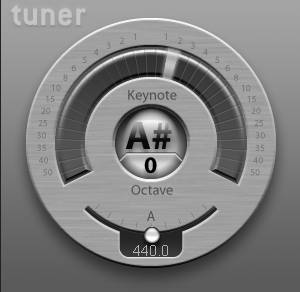
-
MIDI triggers: By sending a MIDI message that's triggered by the amplitude of a signal, you can automate special effects (for example, triggering a filter with a drum pattern) or use "replacement" utilities to automatically convert sampled audio grooves to MIDI information.
-
Pitch-to-MIDI conversion: Going a step further than amplitude-based MIDI triggers, pitch-to-MIDI converters can be used to generate both pitch and timing information from recording sound. Generally they work only with single-voice instruments (like a trumpet ).
|
| | Plug into plug-ins: Once you become addicted to real-time software signal processing, you're likely to hunger for more plug-ins. Here are a few sites to check out: KVR Audio (www.kvraudio.com): Offers a massive database of " open standards" plug-ins (VST, AU, DX, LADSPA) with daily updates, including freeware plug-ins for every platform FXpansion (www.fxpansion.com): Offers "wrappers" to make your DAW software compatible with plug-in formats the DAW doesn't support on its own. (VST, DirectX, AU, etc.) Digidesign (http://digidesign.com/developers/plugin_info/): Offers a comprehensive guide to plug-ins for Pro Tools and Pro Tools LE with downloadable demos Real World Digital Audio's companion site (www.realworlddigitalaudio.com): Offers the latest plug-in news and a guide to freeware instruments and effects |
- Enterprise Application Integration: New Solutions for a Solved Problem or a Challenging Research Field?
- The Effects of an Enterprise Resource Planning System (ERP) Implementation on Job Characteristics – A Study using the Hackman and Oldham Job Characteristics Model
- Context Management of ERP Processes in Virtual Communities
- Data Mining for Business Process Reengineering
- Development of Interactive Web Sites to Enhance Police/Community Relations
